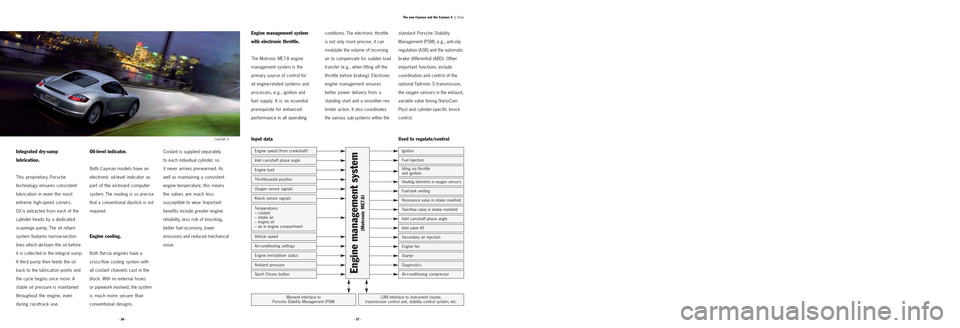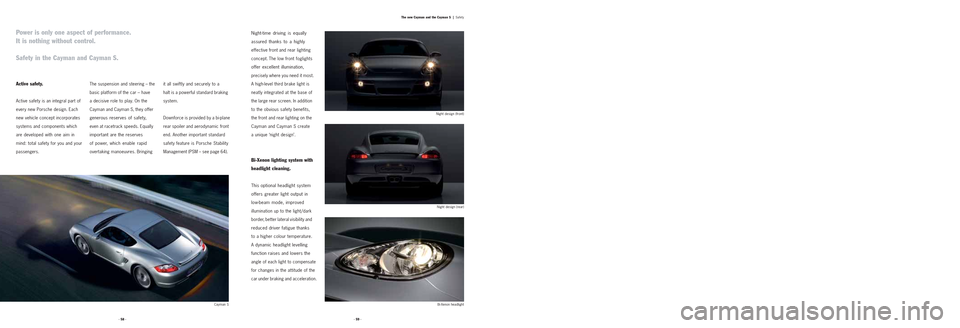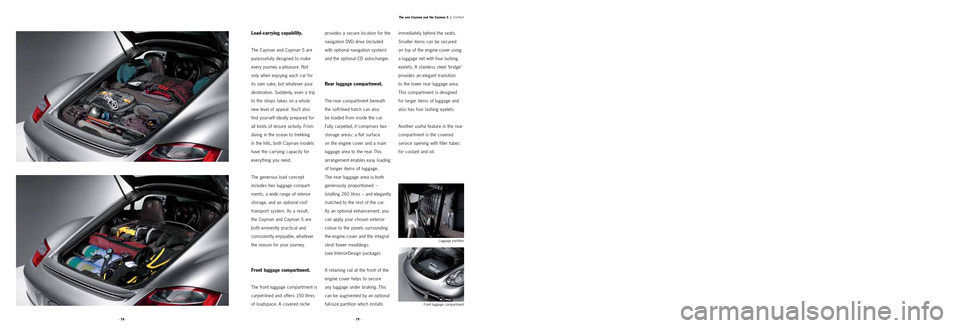ECU PORSCHE CAYMAN 2006 1.G Information Manual
[x] Cancel search | Manufacturer: PORSCHE, Model Year: 2006, Model line: CAYMAN, Model: PORSCHE CAYMAN 2006 1.GPages: 61, PDF Size: 2.24 MB
Page 17 of 61

· 37 · · 36 ·The new Cayman and the Cayman S |
Drive
Integrated dry-sump
lubrication.
This proprietary Porsche
technology ensures consistent
lubrication in even the most
extreme high-speed corners.
Oil is extracted from each of the
cylinder heads by a dedicated
scavenge pump. The oil return
system features narrow-section
lines which de-foam the oil before
it is collected in the integral sump.
A third pump then feeds the oil
back to the lubrication points and
the cycle begins once more. A
stable oil pressure is maintained
throughout the engine, even
during racetrack use.
Oil-level indicator.
Both Cayman models have an
electronic oil-level indicator as
part of the on-board computer
system. The reading is so precise
that a conventional dipstick is not
required.
Engine cooling.
Both flat-six engines have a
cross-flow cooling system with
all coolant channels cast in the
block. With no external hoses
or pipework involved, the system
is much more secure than
conventional designs.
Coolant is supplied separately
to each individual cylinder, so
it never arrives pre-warmed. As
well as maintaining a consistent
engine temperature, this means
the valves are much less
susceptible to wear. Important
benefits include greater engine
reliability, less risk of knocking,
better fuel economy, lower
emissions and reduced mechanical
noise.
Engine management system
with electronic throttle.
The Motronic ME7.8 engine
management system is the
primary source of control for
all engine-related systems and
processes, e.g., ignition and
fuel supply. It is an essential
prerequisite for enhanced
performance in all operating
conditions. The electronic throttle
is not only more precise, it can
modulate the volume of incoming
air to compensate for sudden load
transfer (e.g., when lifting off the
throttle before braking). Electronic
engine management ensures
better power delivery from a
standing start and a smoother rev-
limiter action. It also coordinates
the various sub-systems within the
Used to regulate /control
Engine management system
(Motronic ME7.8)
Engine load
Throttle-pedal position
Oxygen sensor signals
Engine speed (from crankshaft)
Inlet camshaft phase angle
Knock sensor signals
Vehicle speed
Air-conditioning settings
Engine immobiliser status
Ambient pressure
Sport Chrono button
Temperatures
– coolant
– intake air
– engine oil
– air in engine compartment
Ignition
Fuel injection
Idling via throttle
and ignition
Heating elements in oxygen sensors
Fuel-tank venting
CAN interface to instrument cluster,
transmission control unit, stability control system, etc.Moment interface to
Porsche Stability Management (PSM)
Input data
Twin-flow valve in intake manifold
Resonance valve in intake manifold
Inlet camshaft phase angle
Inlet valve lift
Secondary air injection
Engine fan
Starter
Diagnostics
Air-conditioning compressor
standard Porsche Stability
Management (PSM), e.g., anti-slip
regulation (ASR) and the automatic
brake differential (ABD). Other
important functions include
coordination and control of the
optional Tiptronic S transmission,
the oxygen sensors in the exhaust,
variable valve timing (VarioCam
Plus) and cylinder-specific knock
control.
Cayman S
Page 28 of 61

· 59 · · 58 ·The new Cayman and the Cayman S |
Safety
Power is only one aspect of performance.
It is nothing without control.
Safety in the Cayman and Cayman S.
Active safety.
Active safety is an integral part of
every new Porsche design. Each
new vehicle concept incorporates
systems and components which
are developed with one aim in
mind: total safety for you and your
passengers.The suspension and steering – the
basic platform of the car – have a decisive role to play. On the
Cayman and Cayman S, they offer
generous reserves of safety,
even at racetrack speeds. Equally
important are the reserves
of power, which enable rapid
overtaking manoeuvres. Bringing
Night-time driving is equally
assured thanks to a highly
effective front and rear lighting
concept. The low front foglights
offer excellent illumination,
precisely where you need it most.
A high-level third brake light is
neatly integrated at the base of
the large rear screen. In addition
to the obvious safety benefits,
the front and rear lighting on the
Cayman and Cayman S create
a unique ‘night design’.
Bi-Xenon lighting system with
headlight cleaning.
This optional headlight system
offers greater light output in
low-beam mode, improved
illumination up to the light/dark
border, better lateral visibility and
reduced driver fatigue thanks
to a higher colour temperature.
A dynamic headlight levelling
function raises and lowers the
angle of each light to compensate
for changes in the attitude of the
car under braking and acceleration.
Night design (rear)
Bi-Xenon headlight Night design (front)
Cayman S
it all swiftly and securely to a
halt is a powerful standard braking
system.
Downforce is provided by a bi-plane
rear spoiler and aerodynamic front
end. Another important standard
safety feature is Porsche Stability
Management (PSM – see page 64).
Page 38 of 61

· 78 ·The new Cayman and the Cayman S |
Comfort
· 79 ·
Load-carrying capability.
The Cayman and Cayman S are
purposefully designed to make
every journey a pleasure. Not
only when enjoying each car for
its own sake, but whatever your
destination. Suddenly, even a trip
to the shops takes on a whole
new level of appeal. You’ll also
find yourself ideally prepared for
all kinds of leisure activity. From
diving in the ocean to trekking
in the hills, both Cayman models
have the carrying capacity for
everything you need.
The generous load concept
includes two luggage compart-
ments, a wide range of interior
storage, and an optional roof
transport system. As a result,
the Cayman and Cayman S are
both eminently practical and
consistently enjoyable, whatever
the reason for your journey.
Front luggage compartment.
The front luggage compartment is
carpet-lined and offers 150 litres
of loadspace. A covered nicheprovides a secure location for the
navigation DVD drive (included
with optional navigation system)
and the optional CD autochanger.
Rear luggage compartment.
The rear compartment beneath
the soft-lined hatch can also
be loaded from inside the car.
Fully carpeted, it comprises two
storage areas: a flat surface
on the engine cover and a main
luggage area to the rear. This
arrangement enables easy loading
of longer items of luggage.
The rear luggage area is both
generously proportioned –
totalling 260 litres – and elegantly
matched to the rest of the car.
As an optional enhancement, you
can apply your chosen exterior
colour to the panels surrounding
the engine cover and the integral
strut tower mouldings
(see InteriorDesign package).
A retaining rail at the front of the
engine cover helps to secure
any luggage under braking. This
can be augmented by an optional
full-size partition which installs
Front luggage compartmentLuggage partition
immediately behind the seats.
Smaller items can be secured
on top of the engine cover using
a luggage net with four lashing
eyelets. A stainless steel ‘bridge’
provides an elegant transition
to the lower rear luggage area.
This compartment is designed
for larger items of luggage and
also has four lashing eyelets.
Another useful feature in the rear
compartment is the covered
service opening with filler tubes
for coolant and oil.